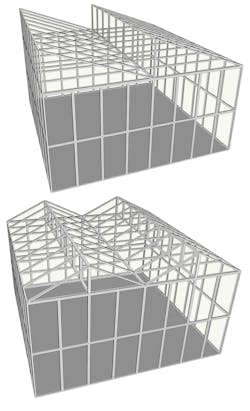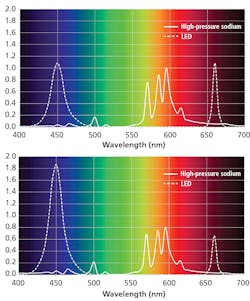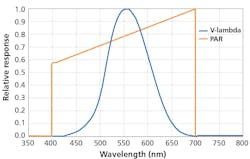IES RP-45-21 delivers guidance for horticultural lighting in design terms (MAGAZINE)(UPDATED)
Search for the phrase “horticultural lighting” online and you will quickly be inundated with over 100,000 results. Add the qualifier “book” and you will get … nothing. To learn even the basics of horticultural light design, you have to wade through seemingly endless two-page magazine articles, product announcements, and innumerable academic papers … but no more. The Illuminating Engineering Society has announced its publication of IES RP-45-21, Recommended Practice: Horticultural Lighting.* [Editor's note: See addendum and update on the status of IES RP-45-21 at the end of this article.]
If you are unfamiliar with the topic, you might think of horticultural lighting as row upon row of high-pressure sodium (HPS) or LED luminaires in greenhouses, or perhaps LED strips illuminating stacked micro greens in vertical farms, with no particular lighting design involved. If so, IES RP-45 with its 80-plus pages of design information will surely convince you otherwise. The document, written over a period of two years by 26 experts in lighting design, horticulture, botany, radiometry, and other fields, covers all aspects of horticultural lighting. Its primary purpose is to provide both lighting professionals and horticulturalists with a common understanding of the topic, and a means of communicating effectively. This article provides a quick overview of the document’s contents.
Definitions
IES RP-45 begins with definitions that are specific to horticultural lighting. The terms may be confusing at first, but many of them correspond with familiar lighting terminology. Photosynthetic photon flux (PPF), for example, is the conceptual equivalent of luminous flux, photosynthetic photon intensity (PPI) corresponds to luminous intensity, photosynthetic photon flux density (PPFD) to illuminance, and so on.
There are of course terms that are specific to horticultural lighting, such as Daily Light Integral (DLI) and photoperiod, but they are easily understood by lighting professionals.
Botany overview
While there is no need for lighting professionals to understand the details of plant anatomy and physiology, it is necessary to understand the basics of plant photobiology. Beyond photosynthesis (converting light, carbon dioxide, and water into chemical energy), there is photomorphogenesis (development of the form and shape of the plant), phototropism (orientation of its leaves to maximize photosynthesis), shade avoidance (competing with neighboring plants for light), circadian rhythms, secondary metabolites production (organic compounds that protect the plant and attract pollinators), and more.
All of these effects are mediated by the irradiance and spectral power distribution (SPD) of optical radiation received by the plants, along with temperature, water availability, and other resources. In order to design optimal horticultural lighting, whether it is electric lighting or daylight, it is necessary to understand light-plant interactions.
Optical radiation spectra
Photosynthesis occurs when plants absorb optical radiation with wavelengths ranging from 400 nm (deep blue) to 700 nm (deep red). This photosynthetically active radiation (PAR) is important, but plants also respond to ultraviolet radiation (280–400 nm), and far-red radiation (700–800 nm). UV-C radiation (100–280 nm) is blocked by the Earth’s atmosphere, but UV-C germicidal lamps are useful in stimulating plant defenses against pathogens.
Plants have a variety of photoreceptors that enable them to distinguish and respond to specific spectral ranges. Chlorophylls and beta-carotene absorb blue (400~500 nm), green (500~530 nm), and red (600~700nm) light for photosynthesis. UVR8 responds to UV-B (280–315 nm) to provide protection against pests and increase the production of antioxidants and other secondary metabolites Cryptochromes and phototropins sense UV-A radiation (315–400 nm) and blue light (400~500 nm) to control circadian rhythms, shade avoidance responses, phototropism, and secondary metabolites production. Phytochromes respond to red (600–700 nm) and far-red (700–800 nm) light to control shade avoidance responses, circadian rhythms, and secondary metabolites production. Plants also respond to yellow (530~600 nm) light, but the photoreceptors have not yet been identified.
Botanists and horticulturalists continue their research into these photoreceptors and their effects on plants, but even basic knowledge of plant responses (often species-specific) to optical radiation spectra further informs optimal horticultural lighting design.
Photoperiods
Like us, plants have circadian rhythms — they need daily periods of light and darkness. They further have species-specific requirements for the amount of PAR they receive each day, referred as the Daily Light Integral (DLI). IES RP-45 provides a table listing minimum DLI requirements for nearly 70 species of flowering plants, courtesy of the publishers of the North American horticultural industry bible, the Ball Redbook.
Plants that are native to temperate regions may also have DLI requirements that vary with the season. Short-day plants such as cannabis flower only when the day length is shorter than a critical photoperiod, while long-day plants such as spinach flower only when the day length exceeds a critical photoperiod. Floriculturists may take advantage of this behavior by exposing plants to far-red radiation from 725-nm LEDs or incandescent lamps at night, thereby forcing them to flower in time for seasonal markets (such as poinsettias for Christmas).
Light source and luminaires
Lamps and luminaires will of course be familiar to lighting professionals, but they come with a few surprises in horticultural lighting. Single-ended HPS lamps, for example, may have a rated L70 lifetime of 24,000 hours, but many growers will replace them annually because plant photosynthesis is linearly dependent (within limits) on the PAR received, and a 30% reduction in PPF output means a similar loss in plant growth (or a 40% increase in electrical energy costs to maintain a constant PPFD).
This also means that lighting uniformity is more critical than it is in architectural lighting design. In general, a uniformity of ±10% across the plant canopy is desirable, although this can be difficult to achieve in greenhouses near the walls due to the low reflectivity of clear glazing.
Another surprise is active cooling of LED luminaires. Mechanical components such as fans are not advisable, as horticultural luminaires often require IP65 or IP66 enclosures for damp and wet environments. One solution is to use circulating water with remote heat exchangers.
Other than this, electrical issues such as power factor, inrush current, surge protection, and lighting controls will be familiar to most lighting professionals, although at typically 30–50W/ft2 for greenhouses, industrial design practices are the norm.
Daylight
Climate-based annual daylighting design may be a familiar concept to architectural lighting designers, with design metrics such as spatial Daylight Availability (sDA) and Annual Sunlight Exposure (ASE), but surprisingly it is mostly unfamiliar to many horticulturalists and greenhouse operators. As one respected textbook on greenhouse design and control states, “The light level in the greenhouse should be adequate and uniform for plant growth” … and nothing more is said on the topic of lighting.
Online DLI calculators can be used to determine the monthly average DLI from historical weather records for open fields anywhere in the world, but the DLI inside a greenhouse is dependent on the building orientation, roof style, and glazing type (Fig. 1). Moveable shades are used to limit the amount of sunlight exposure and retain heat at night, while supplemental electric lighting (HPS or LED) is used to maintain minimum DLIs for crops during winter months. These are design issues that architectural lighting designers are familiar with.
Greenhouses can also generate excessive light pollution at night, much to the annoyance of nearby residents. This is a problem that will be familiar to lighting designers involved in outdoor lighting design, particularly with the high blue content of LED luminaires (Fig. 2). Municipalities with high concentrations of commercial greenhouses are passing municipal legislation mandating light abatement screens.
Vertical farms
Vertical farms are fully enclosed controlled environments with stacked trays of plants and LED strip lighting. As these and indoor growing of cannabis become more popular and profitable, government agencies are responding with legislation to limit lighting power densities (often based on the availability of electrical power to some areas) and luminaire photosynthetic photon efficacy (PPE).
PPE, expressed as micromoles per joule (µmol/J), is an important metric for horticultural luminaires, particularly for those approved by the DesignLights Consortium for utility company rebates.
Agricultural films
There are an estimated 500,000 hectares (1.2 million acres) of greenhouses worldwide, but over 5 million hectares (12 million acres) of plastic film-covered polytunnels, also known as “hoop greenhouses.” Located in mostly subtropical climates, they have no need for supplemental electric lighting.
It might seem curious to discuss agricultural films in the context of horticultural lighting, but they of course involve daylight, and their optical properties are important to horticulturalists and farmers. It is therefore useful for lighting professionals to understand their properties and applications. Photoselective films are a good example, where fluorescent dyes or phosphors embedded in the film absorb UV radiation and re-emit it as red light that the plants can use for photosynthesis. Other films may contain mineral fillers and white pigments to diffuse light and prevent sunburnt leaves, block UV light for shade-loving plants and inhibit mold reproduction, transmit near-infrared radiation (thermic films) to retain heat, or block it to prevent water loss through evaporation and maintain cooler temperatures.
Future greenhouses will likely use photovoltaic films that both transmit light for plant growth and generate power for storage and use by supplemental electric lighting.
Optical sensors
A key metric for horticultural lighting is PPFD which, like illuminance, is spectrally-weighted irradiance. It can be measured with a PAR (quantum) meter, a spectroradiometer (with appropriate software), or in some situations, an illuminance meter.
PAR meters are available with a range of prices, but you have to be careful. Inexpensive units are suitable for measuring daylight and broadband light sources in greenhouses and vertical farms, but the more expensive units are preferred for accurate measurements of horticultural LED luminaires with narrowband LEDs. Examples include the 450-nm blue and 660-nm red LEDs chosen to maximize the photosynthesis rate, and 725-nm far-red LEDs intended to manipulate phytochrome-mediated responses.
Spectroradiometers can also be used to measure PPFD, but again you have to be careful — inexpensive instruments may not be accurate with narrowband light sources. In general, a full-width half-maximum (FWHM) bandpass of 5 nm or less is preferred.
Finally, there are illuminance meters. PAR meters and illuminance meters have different spectral responses, so they cannot be used for PAR measurements (Fig. 3). However, it is not unusual to find horticultural textbooks stating lighting requirements for greenhouses and open fields in footcandles. (The Ball Redbook is a good example.) The logic of this is that the SPD of daylight is remarkably constant, and so illuminance meter readings can be converted into PPFD values with acceptable accuracy using a conversion factor of 18.2 micromoles per second per square meter (µmol/s-m2) per kilolux for daylight only.
Lighting design process
The design process for horticultural lighting is basically the same as that for architectural lighting, but with a few application-specific modifications. See IES RP-45 for details.
Horticultural lighting design involves more than greenhouses and vertical farms. For architectural lighting designers, perhaps a more relevant issue is the design of lighting for building atria and living walls. This means that lighting designers will need to broaden their conversations with the architects to include daylighting design and the choice of glazing materials — plants have lighting requirements that may be at odds with those of humans occupying the space.
Included are PPFD requirements for over 40 desk and floor plants and trees commonly found in building atria, with approximate conversion factors from lux to µmol/s-m2 for common white light sources. There is also information on the need to acclimatize plants ranging from potted shrubs to multi-story trees for up to 18 months in order for them to thrive under low light conditions.
Summary
It is important to note that the recommendations of IES RP-45 are based not on expert opinions, but on horticultural and botanical research current to May 2021. The list of references includes some 160 academic papers, all of which were used in support of the information presented in the document.
IES RP-45 is a long and necessarily complex document about a demanding topic. From a lighting design perspective, the installation of horticultural luminaires in a greenhouse, vertical farm, or building atria may appear to be an entirely straightforward endeavor. However, plants are not people. Successful horticultural lighting design requires in-depth knowledge and a willingness to communicate with horticulturalists and farmers. IES RP-45 provides a basis for the conversation, and will be available in the IES Lighting Library at https://bit.ly/3nwz0IF.
This article was submitted by Ian Ashdown, FIES, as a joint effort of the Illuminating Engineering Society (IES) Horticultural Lighting Committee.
Get to know our expert
IAN ASHDOWN, FIES, is a senior scientist at SunTracker Technologies, Ltd. A senior member of the Optical Society of America (OSA) and a recipient of the Illuminating Engineering Society Gold medal, Ashdown has multiple patents and publications to his credit. With experience in electrical and software engineering, he has specialized knowledge of photometrics, radiometry, and colorimetry, and has worked with companies such as the former TIR Systems Ltd., Cooledge Lighting, and Lighting Analysts. Ashdown is a frequent presenter at LED and SSL industry events, including Strategies in Light and the HortiCann Light + Tech Conference. He holds BAppSc and MSc degrees from the University of British Columbia.
IES RP-45-21 Article - Correction and Apology
Ian Ashdown, FIES
IES Horticultural Lighting Committee Chair
In my article "IES RP-45-21 Delivers Guidance for Horticultural Lighting in Design Terms" (June 1st, 2021), I wrote, "The Illuminating Engineering Society has announced its publication of IES RP-45-21, Recommended Practice: Horticultural Lighting."
This was incorrect, and I apologize for any confusion this may have caused. While the document is expected to be published by the end of this year, no firm publication date has been announced. The document is under ANSI public review through September 6th, 2021, and depending on comments received may need further revision and committee voting.
IES policy – which I agree with – is to not discuss draft standards in public prior to publication. When I wrote the article, it was the culmination of an arduous three-year effort by the IES Horticultural Lighting Committee and its more than two dozen volunteer members to write the documents. Suffice it to say that my relief in completing this task clouded my judgment in writing the summary article.
IES RP-45 will be an essential guide to horticultural lighting design, but we will all have to simply wait until it is published.
*Updated with correction notice Aug. 16, 2021 2:30 PM. LEDs Magazine regrets the error and looks forward to future updates from the Illuminating Engineering Society (IES) upon final review and publication of IES RP-45-21.
Enjoyed this article? Visit our digital magazine for more like this >>









